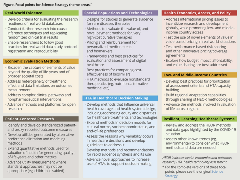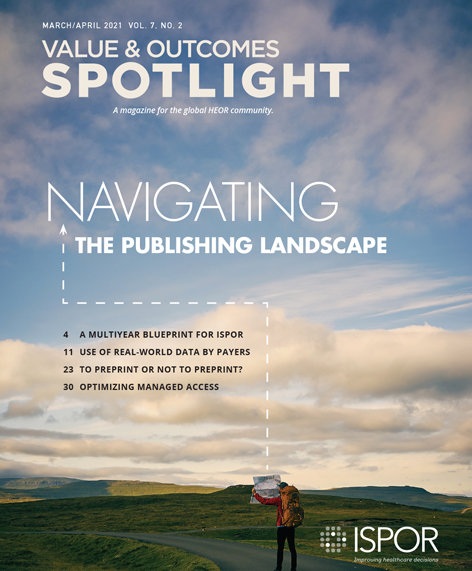ISPOR’s Science Strategy: A Multiyear Blueprint
Richard J. Willke, PhD, Chief Science Officer, ISPOR

ISPOR’s Science Strategy, released in the first quarter of 2021 as a directive in ISPOR’s Strategic Plan Update 2024, is a multiyear blueprint that will guide the Society’s efforts and mission-focused initiatives. The objective of the ISPOR Science Strategy is to identify a targeted set of topical “themes” and focal points for research that the Society believes will have the greatest impact on both the field of health economics and outcomes research (HEOR) and global healthcare. The intention is that this strategy can be leveraged to advance the science, drive innovation in the field, and have an even greater impact on improving healthcare decisions.
The development of ISPOR’s Science Strategy was heavily informed by its members. As a member-driven organization, the Society relies on member input to guide all that it does. The first step in development of the Science Strategy was to gather topic suggestions by conducting a comprehensive survey of the members of the Society’s various groups, including its councils, special interest groups, board of directors, regional and student chapters, editorial boards, current and former task forces, etc. This initial survey resulted in 908 suggestions from members of 122 member groups representing more than 45 countries. The subsequent work to synthesize and summarize these research topics was led by ISPOR’s most senior advisory body, the Health Science Policy Council, and was approved by ISPOR’s Board of Directors in the Fall of 2020. ISPOR is most grateful to its membership for the robust response to this effort. Members’ enthusiasm for progressing the science of HEOR is clear.
"...this strategy can be leveraged to advance the science, drive innovation in the field, and have an even greater impact on improving healthcare decisions." —Richard J. Willke, PhD
The Science Strategy provides direction in 8 different themes of HEOR science and application, outlined below. It covers most key areas of HEOR work, while calling out specific areas of focus in each theme—these focal points are outlined in the Figure. It is also important to note that while the Science Strategy is expected to define the greater part of ISPOR’s coming activities, new ideas are always welcomed and will certainly arise.
Real-World Evidence: Make HEOR evidence based on real-world data credible and reliable for use in healthcare decision making. The great potential for use of real-world data in healthcare research and decision making remains limited due to concerns about data quality, ability to discern causality, and the transparency and reproducibility of the research process. While excellent progress has been made in each of these areas, that progress has not yet led to good practices becoming common practices, or to a broader understanding of under what circumstances (and for what purposes) evidence derived from real-world data can be trusted.
Economic Evaluation Methods: Stimulate methodological innovation in health economic evaluation and value assessment to better capture the complexities of new technologies and healthcare processes. The core methods of health economic evaluation are generally well established but may not reflect some important considerations that affect real-world decision making. For example, there are important insights from behavioral economics, more complex clinical pathways with treatment sequences and other trajectory modifiers, societal values that embrace dimensions beyond those in the standard quality-adjusted duration of life, and novel therapies that may be curative. In addition, understanding of the importance of variation—due to heterogeneity or residual uncertainty, including structural—has advanced, but methods for factoring that variation into such evaluations are just beginning to develop.
Patient-Centered Research: Refine the measurement of patient- and proxy-reported outcomes and preferences to improve their veracity, rigor, and usefulness for healthcare decisions. There are still major gaps in the availability of standardized clinical outcomes that are meaningful to patients and/or patient- (or proxy-) reported outcomes that produce evidence relevant both for health state utilities for economic evaluation and for healthcare decision making in general, particularly for special populations (eg, children, chronically disabled). Stated-preference research can be used to evaluate the relative importance of dissimilar treatment features and health outcomes and provide empirical evidence to inform value judgments.
Special Populations and Technologies: Identify innovations and adaptations of HEOR methods that target selected areas of disease management and decision making (eg, rare disease, precision medicine, etc). Special populations and technologies are defined as those with unique features that pose particular challenges for evidence generation, health technology assessment (HTA), economic evaluation, and outcomes research. Examples include treatments for rare diseases, gene therapies, biosimilars, medical nutrition, and digital health monitoring, among others.
HTA in Healthcare Decision Making: Identify approaches that strengthen the linkage between HTA and healthcare decision making to improve the efficiency, transparency, and fairness of both. HTA has the potential to play an integral role in healthcare decision making. In practice, it often has less impact than expected. Strengthening the connection between HTA and healthcare decision making should enable HTA to reach this potential. Appropriate institutionalization of HTA, a greater degree of participation by different stakeholders, and improved transparency in the HTA process (as well as the criteria used by the decision makers) can improve the efficiency, transparency, and perceived fairness of this process.
"HEOR, as a blend of social, healthcare, and data sciences, provides a framework that can clearly define healthcare issues and generate the relevant evidence to inform healthcare decision making." —Richard J. Willke, PhD
Health Economics, Access, and Policy: Develop health economics and HTA tools that apply to health policy, research and development, pricing, and reimbursement to optimize and balance the needs of access, sustainability, and innovation. Given patents and data exclusivity, how should products be priced to ensure the maximum access compatible with providing the maximum long-run health gains from innovation? Cost-effectiveness analysis remains a standard but much-debated approach to assessing value and determining prices. To better capture some aspects of value, a number of modifications to cost-effectiveness analysis have recently been suggested but need further exploration and testing. Separate from—but related to—pricing is coverage and reimbursement by a payer, where there are a wide variety of coverage paradigms across payers/countries as well as across types of drugs (eg, orphan drugs or accelerated approvals).
Low- and Middle-Income Countries: Promote HEOR methods and resources that support HTA across the diverse range of health systems including low- and middle-income countries. As more countries move toward a universal healthcare coverage model, prioritization within limited budgets is paramount. HEOR methods can be used and adapted in many different types of healthcare systems to help facilitate and align priority setting across all aspects of a health delivery system, regardless of the stage of the country’s development. However, these methods are only helpful if there is synergy across problem definition, evidence generation, and decision making. Compounding this issue is that most HTA systems, structures, and standards are generally driven by developed countries. Thus, there is a need to better understand the applicability and sustainability of HEOR approaches especially for low- and middle-income countries.
Resilient, Learning Healthcare Systems: Develop HEOR methods and applications that contribute to resilient, learning healthcare systems. Healthcare systems are intertwined with many other aspects of how we live and how society functions—our economy, our environment, our demographics, our legal system, etc. The COVID-19 pandemic has highlighted the interconnectedness of health, public health, and the larger economy. To inform decisions that may have cross-sector ramifications, HEOR researchers should broaden their perspectives to include nonhealth-related outcomes, such as effects on the larger economy, educational outcomes, housing, and social welfare. We should also seek to collaborate with other disciplines that provide complementary perspectives and methods that will help us address these issues more comprehensively.
ISPOR’s Science Strategy is intended to help inform and guide our content strategies and member group activities for the next several years. ISPOR will incorporate Science Strategy elements into its business plans, content strategies, discussions, and program themes. It is also meant to inform the Society’s stakeholders and the broader healthcare audience about current areas of interest for both ISPOR and the global HEOR community. We highly encourage its use for discussions and coordinated activities across ISPOR member groups.
The need has never been greater for HEOR to inform healthcare decisions. Healthcare’s myriad challenges—the COVID-19 pandemic, the growth of innovative (but expensive) curative therapies, the move toward universal healthcare, the need to provide optimal health outcomes for patients within budget constraints, to name a few—combined with the increasing complexity of healthcare—bring the demand for HEOR to the forefront. HEOR, as a blend of social, healthcare, and data sciences, provides a framework that can clearly define healthcare issues and generate the relevant evidence to inform healthcare decision making. If well-focused on today’s healthcare challenges, HEOR has the potential to markedly improve societal well-being and make a real impact in the lives of patients.
Figure. Focal points for Science Strategy theme areas.*

HEOR indicates health economics and outcomes research; HTA, health technology assessment.
* For the complete versions of these focal points, please see the original Science Strategy.
Explore Related HEOR by Topic

